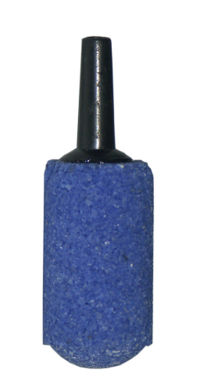Airstone
An airstone is a device fitted onto the end of a length of air-hose that typically diffuses air into the water.
The typical airstone is a porous blue stone (ceramic), with a plastic nozzle which takes 6mm diameter air hose. However they are also available in many different sizes and colours to suit the aquarium décor.
The material is actually made up of small particles of stone which are compressed by machine to form a solid mass with fine gaps throughout it.
Many different types are available for specialist uses.
- Ceramic or stone - Most common. Though the action of algae and bacteria causes the airstone to clog after a few months.
- Wood - These types produce very fine mist-like air bubbles. Primarily used in salt water tanks.
- Plastic - plastic rings held together by a clip. Designed to be longer lasting than stone and can be cleaned for further use.
Note[edit]
Oxygen in the air actually takes a long time (typically 90 seconds for an average sized bubble) to dissolve into the water via an airstone. It is the action of rising bubbles which causes water movement from the bottom of the aquarium, where oxygen levels will be lower, to the surface where the oxygen from the air can diffuse. The bubbling water surface actually has a larger surface area so allowing more oxygen to diffuse over time.
Some aquarists place a submerged powerhead in the aquarium with an airstone underneath. The action of the powerhead causes the air bubbles to be broken up into millions of tiny bubbles which greatly increases the surface area and so increases the rate of oxygen diffusing into the water.
- Aeration is not good for planted tanks during the day as the increased surface agitation causes CO2 in the water to be released and so plants can suffer from lack of CO2 to grow.
- Aquarists with a planted tank often however apply aeration during the night to ensure their artificially added CO2 plus the CO2 released by plants doesn't cause a oxygen shortage during lights out.
- Other use for a airstone is to break up bio-film or scum build-up on the water surface which can lead to oxygen starvation below.
